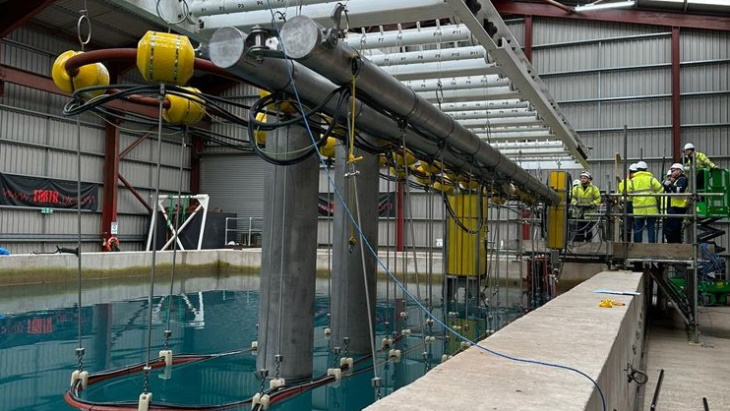A new technique for removing sludge from nuclear fuel ponds has been successfully trialled at one of the UK's largest wet test facilities prior to being used at a nuclear site.

TDA testing at Forth's Deep Recovery Facility (Image: Forth)
The Decommissioning Alliance (TDA) - a partnership comprised of Jacobs, Atkins and Westinghouse - is tasked with installing equipment to allow operators to safely retrieve debris from the bottom of fuel ponds at a site operated by the Nuclear Decommissioning Authority (NDA) in order to safely remove and transport the recovered material for safe, long-term storage.
TDA representatives will complete the task by attaching a Bulk Sludge Retrieval Tool (BSRT), which ultimately acts like an industrial hoover, to a 40-metre cable. The tool will retrieve the sludge and then store it in a safe manner.
To test the new way of working, which includes the use of remotely operated vehicles to lock a hinged double boom arm in position, the team trialled the methods at engineering specialists Forth's Deep Recovery Facility (DRF) at the company's headquarters in Flimby, Cumbria.
Measuring 22.5 metres long, 10 metres wide and six metres deep, the DRF at Forth is able to hold 1.2 million litres of water, making it the largest facility of its kind in the north of England.
To facilitate the tests, engineers at Forth designed and manufactured a frame to attach the equipment, and they provided access scaffolding and operators to deploy the equipment.
"The work we are carrying out at the site has been ongoing since 2010 and has been instrumental in reducing the inventory in the pond, which in turn reduces the overall risk," said TDA Project Manager Scott Bond. "We are always looking for ways to ensure our work is safer, more efficient and more cost effective for the client, and the new methodology of installing the BSRT and the umbilical has the potential to be a game changer.
"Before implementing the practices live on-site, we need to be 100% certain that they are safe and effective, so the trials we carry out are absolutely essential. Being able to successfully test the equipment at Forth's DRF, particularly when it's on our doorstep, was a Godsend for the project because we couldn't find a facility big enough to host the trials; other than the open sea or a dock, but that brings with it more hindrances as the water is very corrosive."
Bond added that using the indoor DRF meant TDA was able to successfully trial the methods and replicate site conditions on more than one occasion, ensuring the installation team are familiar with the equipment, tooling and installation sequence, when the time comes to actually using the technique at the NDA site.
"It's been great to be able to play a part in what is such a major development for the nuclear industry," said Graham Cartwright, the projects director at Forth. "Our DRF has time and again proved vital in providing wet testing for key projects and being in a position to facilitate these trials has been something we are really pleased with."